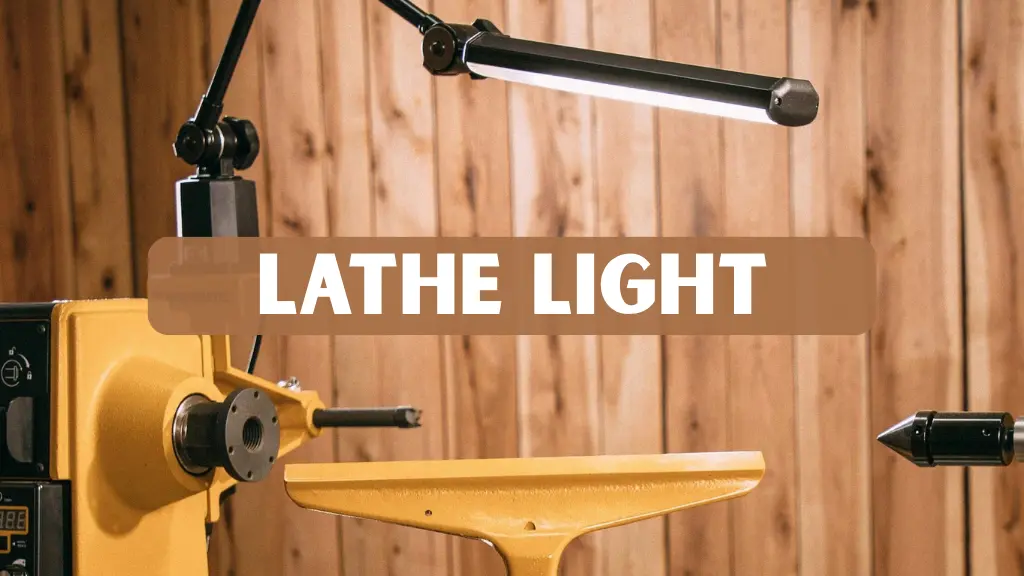In workshops, lighting is often overlooked, but for anyone working with wood or metal, visibility can make the difference between a flawless project and an imperfect one. A well-designed lathe light provides focused illumination directly on the working area, ensuring precision, improving safety, and reducing eye strain during long sessions.
Proper lighting is essential for accurate cuts, smooth finishes, and consistent results. Woodturners, machinists, and hobbyists all benefit from installing a dedicated workshop light in their workspace. Over the years, advancements in LED technology have significantly improved efficiency and visibility. This guide explores the types of lights available, their features, installation tips, maintenance, and practical examples from experienced professionals.
Why Lighting Matters in Precision Work
When operating a lathe, careful attention to detail is essential, as even small errors in alignment or depth can result in costly mistakes. Poor lighting can lead to misjudged angles and tool placement, overlooked cracks or rough edges, reduced visibility on curved or reflective surfaces, and increased eye fatigue, all of which slow down work and increase the risk of errors.
Using a focused lathe light addresses these challenges by providing direct illumination exactly where it is needed. Enhanced visibility allows craftsmen to maintain accuracy, minimize mistakes, and work in a safer environment. Additionally, proper lighting reduces eye strain, enabling longer work sessions without discomfort and making projects more enjoyable and productive.
The Benefits of Using a Lathe Light
A dedicated lathe light serves as more than just a convenient accessory, it is an essential tool in any workshop. Clear and focused illumination improves safety by reducing the risk of accidents when handling sharp tools or spinning materials. Proper lighting also enhances accuracy, allowing craftsmen to detect small imperfections and make precise cuts, which is crucial for high-quality work.
In addition, good lighting increases efficiency by enabling faster work with fewer mistakes, while reducing eye strain and fatigue during extended sessions. Consistently well-lit workspaces also lead to professional results, producing smoother finishes and more uniform shapes. Workshops that prioritize proper lighting regularly achieve higher-quality outcomes while maintaining strong safety standards.
Types of Light for Lathe
Choosing the right type of lathe light depends on your workspace, the nature of your projects, and your personal preferences. LED lights are highly popular because they are energy-efficient, long-lasting, and produce very little heat. Their bright, focused illumination is perfect for detailed woodturning or metalworking tasks. Many models also feature adjustable arms, allowing precise positioning for optimal visibility.
Halogen lamps provide bright, warm light that enhances visibility for fine details. They are particularly favored in traditional workshops where warm tones are preferred. Halogen lights offer excellent color rendering, allowing craftsmen to see subtle features clearly. However, they produce more heat and have a shorter lifespan compared to LED alternatives.
Fluorescent lights are another option, offering broad illumination at a lower cost. These lights are effective for general workshop lighting but do not provide the precise focus needed for intricate turning work. Additionally, fluorescent lamps can be bulky and are less durable in dusty or vibrating workshop environments. Flexible arm or gooseneck lights solve some of these issues by providing maximum adjustability.
Magnetic base lights provide portability and can attach securely to metal surfaces, making them useful in shared workspaces or for multiple workstations. Their versatility allows craftsmen to reposition lighting as needed for different projects. The main limitation is that they require metal surfaces and can become obstructive in crowded workshops. Understanding these options helps craftsmen select lighting that improves both safety and productivity.
Key Features to Consider
Selecting the right workshop illumination involves more than just considering brightness. One of the most important factors is adjustable brightness, as flexible lighting allows craftsmen to tailor illumination for different materials and project scales. Proper light levels ensure that fine details are clearly visible, reducing errors and enhancing overall precision. Color temperature is also crucial, with cooler tones between 5000 and 6500K providing accurate visibility for detailed work, while warmer tones may distort how surfaces appear.
Mounting options play a crucial role in flexibility and convenience. Magnetic bases, clamp-on fixtures, or fixed mounts allow lights to be positioned exactly where needed, while durable construction ensures they can withstand the rigors of a busy workshop. Dustproof and vibration-resistant designs help maintain performance over time, preventing the light from degrading under demanding conditions.
Finally, the ability to adjust the arm, such as with goosenecks or articulated joints, allows precise positioning for complex tasks. Considering the power source is also essential, as corded or rechargeable lamps depend on the workshop layout and mobility requirements. Evaluating these features carefully ensures that the lighting solution enhances safety, efficiency, and the overall quality of work in any workshop.
Real-World Workshop Experiences
Experienced professionals highlight that proper workshop lighting has a significant impact on workflow, accuracy, and overall project quality. In one example, a hobbyist initially relied on a standard desk lamp but upgraded to a flexible task light. This improvement in visibility reduced errors during spindle turning and made the process more enjoyable, demonstrating the value of well-planned lighting in a home workshop setting.
In another case, a professional machinist installed magnetic base LED lamps on each workstation, allowing for easy repositioning based on the project. This setup reduced setup time and increased efficiency by nearly 20 percent. Similarly, a custom furniture maker implemented a dual-light arrangement, combining overhead and workstation-mounted lamps to eliminate shadows completely. These examples illustrate that investing in proper task lighting not only enhances productivity but also ensures higher-quality outcomes and safer working conditions.
Installation Tips
Proper installation is crucial for safe and effective workshop lighting. Strategically positioning lights prevents shadows and glare, providing clear visibility across the entire work area. This allows craftsmen to work with precision and reduces the risk of errors. Well-placed lighting enhances workflow and ensures tasks are completed efficiently. Proper setup forms the foundation of a productive and safe workspace.
Securing mounts, clamps, or magnetic bases is equally important for stability. Unstable fixtures can compromise accuracy and create potential hazards during work. Properly fastened lights remain steady even during vibrations or movement. Consistent illumination supports precision and protects both the user and the materials. Maintaining stability is essential for long-term workshop safety and efficiency.
Careful cable management keeps wires away from moving parts, reducing the risk of accidents and equipment damage. Organizing cords also prevents clutter and allows for easier adjustments of lighting positions. Testing lights under real working conditions ensures proper coverage and functionality. Following these installation practices promotes a safer, more efficient, and productive workspace. Reliable setup contributes to both professional results and overall workshop organization.
Maintenance Guidelines
Regular maintenance is essential to ensure that workshop lighting performs reliably and lasts longer. Dust, wood shavings, and grime can accumulate on lenses and fixtures, reducing brightness and clarity. Cleaning these components frequently helps maintain consistent illumination and prevents small issues from turning into bigger problems.
In addition, it is important to inspect wiring and connections to avoid electrical hazards, and to replace bulbs promptly when they start to dim, as reduced light can lead to mistakes. Checking mounts, clamps, or magnetic bases ensures that lights remain secure and stable during work. Following these practices promotes a safer, more efficient, and productive workshop environment.
Common Mistakes to Avoid
Even skilled craftsmen sometimes make mistakes with workshop lighting, which can impact both safety and the quality of their work. Common issues include using weak or general lights that do not provide adequate illumination, ignoring the importance of color temperature, and focusing only on brightness rather than overall visibility. Improper placement of lamps can create shadows on the workpiece, making it harder to see fine details and increasing the risk of errors.
Neglecting basic safety checks on wiring and mounts is another frequent problem, especially when equipment is moved or adjusted frequently. Additionally, using household lamps not designed for vibration or dust can lead to premature failure or hazards. By paying attention to these aspects and implementing proper lighting practices, craftsmen can ensure a safer, more efficient, and more productive workspace.
Conclusion
Proper lighting is an essential element of precision work, and a well-chosen lathe light can significantly improve safety, accuracy, and overall comfort for both beginners and experienced craftsmen. By selecting the appropriate type, evaluating key features, and adhering to correct installation and maintenance practices, you create the conditions for consistently high-quality results in every project.
Investing in reliable, high-quality lighting is a long-term decision that pays dividends in productivity, fewer errors, and professional-level finishes. Thoughtful planning and attention to detail in your workshop setup can transform the way you work, making tasks more efficient, enjoyable, and safe.
FAQs
What type of light is best for a lathe?
LED lights with adjustable arms are the most practical choice, offering bright, focused illumination without excessive heat.
How many lumens are needed?
800–1500 lumens is typically sufficient for detailed work. Larger lathes may require brighter lights.
Can a desk lamp be used?
While possible, desk lamps are not recommended. They lack the durability, focus, and vibration resistance required in workshops.
Are magnetic base lights reliable?
Yes, they provide versatility and easy repositioning, particularly on metal lathe surfaces.
How can shadows be minimized?
Use multiple lights from different angles, such as one lathe-mounted and one overhead, to eliminate dark spots.




